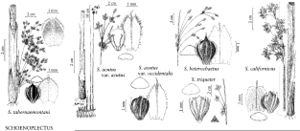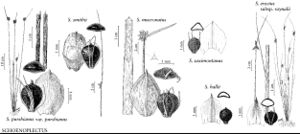Schoenoplectus
Verh. K. K. Zool.-Bot. Ges. Wien 38(Sitzungsber.): 49. 1888.
Herbs, perennial or annual, cespitose or not, rhizomatous or not. Culms solitary or not, cylindric to strongly trigonous, smooth, glabrous, spongy with internal air cavities. Leaves basal, rarely 1 (–2) cauline; sheaths tubular; ligules membranous, glabrous; blades well developed to rudimentary, cross-section dorsiventrally flat to C-shaped or laterally compressed, soft, smooth or margins sometimes distally scabrous or spinulose. Inflorescences terminal, capitate to openly paniculate; spikelets 1–100+; involucral-bracts 1–5, leaflike, proximal bract erect to spreading. Spikelets terete, 3–25 × 2–5 mm; scales deciduous, 8+, spirally arranged, each subtending flower, or proximal scale empty (sometimes called a bracteole), floral scales with apex entire or 2-fid, midrib usually prolonged into mucro or awn, smooth or abaxial surface scabrous, margins ciliate. Flowers bisexual (basal flowers pistillate in amphicarpic species); perianth of 0–6 (–8) bristles, straight or curved, spinulose, straplike, sometimes fringed with soft, blunt hairs, shorter than to somewhat exceeding achene; stamens 3; anthers 3 mm; styles linear, 2–3-fid, base not or scarcely enlarged, deciduous in fruit. Achenes biconvex to trigonous, with apical beak, faintly to prominently rugose or with transverse wavy ridges, 2.5–3.5 mm including 0.1–2 mm beak.
Distribution
Worldwide
Discussion
Species ca. 77 (17 in the flora).
The species of 7d. Schoenoplectus sect. Supini produce two morphologically different types of achenes. They have solitary, pistillate (amphicarpic) flowers enclosed in basal leaf sheaths in addition to the terminal inflorescences on the culms. In amphicarpic flowers perianth bristles are usually absent, when present, 1–2, caducous, and sparsely spinulose; the styles are (2–)3-fid, greatly elongated, stigmas are exserted from sheath orifices; achenes are larger than those found in normal spikelets, and their shape and surface sculpturing are different (A. E. Schuyler 1969; J. Raynal 1976; J. Browning 1992).
Schoenoplectus includes some difficult species complexes, each with different ranges outside of North America, that are discussed under the first species in each complex. The four sections recognized here were delineated by S. G. Smith and E. Hayasaka (2001). About ten species from eastern Asia and Africa have not yet been assigned to a section.
Schoenoplectus californicus and members of the S. lacustris and S. pungens complexes are often ecologically dominant in wetlands, where they provide valuable food and habitat for waterfowl and other animals. In North America their culms are used, mostly historically, for making mats, baskets, chair seats, houses, boats, and other objects. Some species are cultivated as ornamentals. Indicator boxes for weediness are marked here on the basis of the status listed under Scripus.
Users of this treatment should note the following features: colors of unripe achenes, even when they appear to be mature, are usually much paler than ripe achenes; lengths of achenes include beak; lengths of scales include awn; spikelets usually elongate during flowering; and culm thicknesses refer to the middle third of culm.
Selected References
None.
Lower Taxa
Key
| 1 | Spikelet scale apices clearly emarginate to 2-fid; culms (1–)2–15 mm diam.; plants perennial, with rhizomes long, tough, firm, not concealed among culm bases [7a. Schoenoplectus sect. Schoenoplectus]. | > 2 |
| 1 | Spikelet scale apices entire (sometimes very obscurely emarginate); culms (0.5–)2(–3) mm diam.; plants perennial, with rhizomes long, weak, soft, or tufted annuals or perennials with rhizomes short, concealed among culm bases. | > 1 |
| 2 | Culms usually cylindric throughout, occasionally trigonous distally; inflorescences branched. | > 3 |
| 2 | Culms clearly trigonous throughout; inflorescences branched or not. | > 6 |
| 3 | Perianth members 2–4, straplike, fringed with soft, blunt hairs, dark red-brown; spikelet scales smooth or awn sparsely scabrous; leaf blades on distal sheaths absent or to 20 mm; culms clearly to obscurely bluntly trigonous near inflorescence. | Schoenoplectus californicus |
| 3 | Perianth members (4–)6(–8), bristlelike, spinulose, medium brown; spikelet scales densely scabrous to nearly smooth; leaf blades on distal sheaths present, 2–220 mm; culms cylindric throughout. | > 4 |
| 4 | Achenes clearly trigonous; perianth bristles 4(–5), usually 2 much shorter; styles 3-fid; spikelet scales scabrous only on awn and distal part of midrib; spikelets all solitary or some in pairs. | Schoenoplectus heterochaetus |
| 4 | Achenes usually plano- or biconvex, rarely clearly trigonous; perianth bristles (4–)6(–8), usually nearly equal; styles 2-fid or 2–3-fid, rarely all 3-fid; spikelet scales scabrous on awn, midrib, and often flanks, especially in proximal parts of spikelets; spikelets all clustered to all solitary. | > 5 |
| 5 | Spikelet scale awns straight to bent, 0.2–0.8 mm; scales (except often midribs) uniformly orangish, or sometimes straw-colored and prominently spotted at 10X, flanks smooth or very sparsely (rarely densely) scabrous; spikelets often all solitary; widest air spaces in upper 1/4 of culm 1–2.5 mm wide. | Schoenoplectus tabernaemontani |
| 5 | Spikelet scale awns (sometimes broken off) mostly strongly contorted, rarely all straight, 0.5–2 mm; scales wholly or partly pale and prominently spotted at 10X, flanks sparsely to often densely scabrous; some spikelets always clustered; widest air spaces in upper 1/4 of culm 0.5 (east)–1.5(–2.5) (west) mm wide. | Schoenoplectus acutus |
| 6 | Inflorescences branched, or rarely some capitate or of 1 spikelet. | > 7 |
| 6 | Inflorescence unbranched (capitate) [Schoenoplectus pungens complex]. | > 8 |
| 7 | Inflorescences to 2 times branched, of 1–35 spikelets; culms 2–4 mm diam. in middle; perianth members bristlelike, medium brown, spinulose. | Schoenoplectus triqueter |
| 7 | Inflorescences 3 or more times branched, of 25–150+ spikelets; culms 4–10 mm diam. in middle; perianth members straplike, dark reddish brown, with soft, blunt hairs. | Schoenoplectus californicus |
| 8 | Spikelet scale apex notch 0.1–0.4 mm deep, awns 0.2–0.6 mm; distal leaf blade much shorter than to nearly equaling, rarely 1.5 times longer than sheath; proximal inflorescence bract 1–6 cm, other bracts without blades; sides of mid culm deeply concave, rarely nearly flat. | Schoenoplectus americanus |
| 8 | Spikelet scale apex notch (0.3–)0.5–1 mm deep, awns 0.5–1.5(–2.5) mm; distal leaf blade much longer than to rarely equaling sheath; proximal inflorescence bract (1–)3–20 cm, other bracts with narrow blades often exceeding spikelets; sides of mid culm shallowly concave to nearly flat. | > 9 |
| 9 | Spikelets 1–5(–10); perianth bristles very stout to slender, unequal or equal, equaling achene to rudimentary; distal leaf blade several times longer than to rarely equaling sheath; achenes (2–)2.5–3.5 mm, plano- to unequally biconvex or obtusely trigonous; styles 2–3-fid. | Schoenoplectus pungens |
| 9 | Spikelets 3–35; perianth bristles very slender, some exceeding or equaling achene, some much shorter; distal leaf blade equaling to 1.5 times longer than sheath; achenes 1.9–2.6 mm, biconvex; styles 2-fid. | Schoenoplectus deltarum |
| 10 | Achenes smooth, 2.5–4.5 mm, trigonous; plants perennial with long rhizomes; leaf blades not erect, often flaccid [7b. Schoenoplectus sect. Malacogeton]. | > 11 |
| 10 | Achenes rugulose or with sharp transverse ridges, 1–2.2 mm, plane or biconvex, sometimes trigonous; plants tufted annual (rarely perennial) with very short, inconspicuous rhizomes; leaf blades erect, not flaccid. | > 13 |
| 11 | Inflorescences branched; culms trigonous; leaf blades often flaccid and ribbonlike, 2–10 mm wide. | Schoenoplectus etuberculatus |
| 11 | Inflorescences unbranched, rarely 1-branched; culms trigonous or cylindric; leaf blades erect or flaccid and ribbonlike, 0.2–2 mm wide. | > 12 |
| 12 | Culms acutely trigonous throughout, 1.5–5 mm thick; leaf blades 1–2 mm wide, erect, emergent; spikelets 1–4. | Schoenoplectus torreyi |
| 12 | Culms cylindric or clearly trigonous distally, 0.5–1 mm thick; leaf blades 0.2– 1 mm wide, mostly flaccid, submerged; spikelets 1. | Schoenoplectus subterminalis |
| 13 | All leaves basal; spikelet scale midribs not keeled, flanks with 2–10 prominent ribs entirely or proximally; achenes rugulose, without prominent transverse, wavy ridges; amphicarpic flowers absent from leaf sheaths [7c. Schoenoplectus sect. Actaeogeton]. | > 14 |
| 13 | One leaf (rarely 2) cauline distal to leaf sheaths; spikelet scale midribs prominently keeled distally, flanks without ribs; achenes with prominent transverse, wavy ridges; amphicarpic flowers often present in basal leaf sheaths [7d. Schoenoplectus sect. Supini]. | > 16 |
| 14 | Culms acutely trigonous, 2–3 mm thick; leaf blades absent. | Schoenoplectus mucronatus |
| 14 | Culms cylindric, 0.5–2 mm thick; leaf blades present, at least on distal sheaths. | > 15 |
| 15 | Achenes mostly proximally rounded to stipelike constriction, base 0.3–0.4 mm wide; perianth bristles rarely absent, distinctly wider proximally; inflorescence bracts often divergent. | Schoenoplectus purshianus |
| 15 | Achenes mostly proximally evenly tapered, without stipelike constriction, base 0.2–0.3 mm wide; perianth bristles often absent, slender throughout; inflorescence bracts rarely divergent. | Schoenoplectus smithii |
| 16 | Achenes in spikelets nearly equilaterally sharply trigonous; styles all 3-fid. | Schoenoplectus saximontanus |
| 16 | Achenes in spikelets biconcave to plano-convex or obscurely compressed-trigonous; styles 2-fid or a few 3-fid. | > 17 |
| 17 | Achenes adaxially concave or sometimes nearly plane; spikelet scale flanks pale orange to nearly colorless. | Schoenoplectus hallii |
| 17 | Achenes adaxially longitudinally convex or horizontally slightly convex with convex center; spikelet scale flanks often distally orange- or red-brown. | Schoenoplectus erectus |
"shortened" is not a number."prolonged" is not a number.


